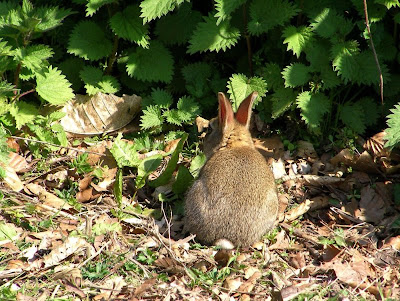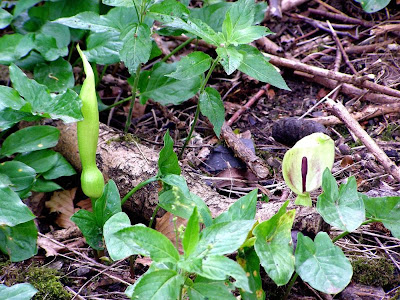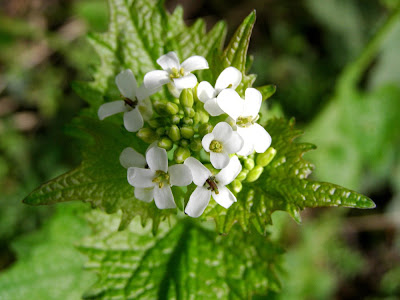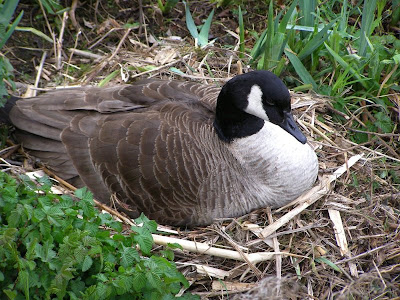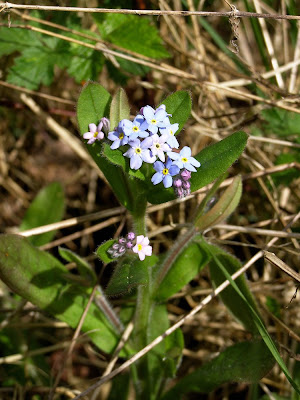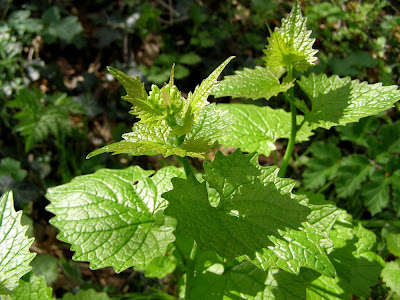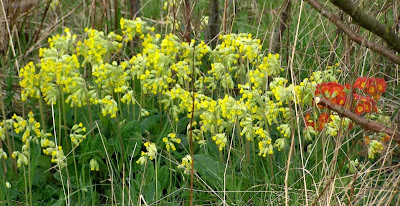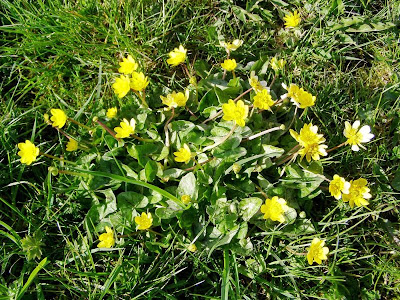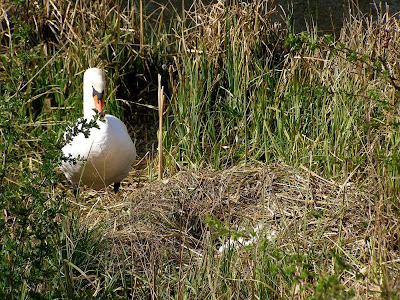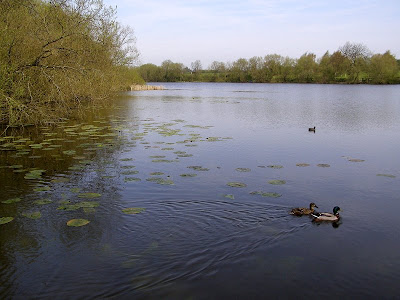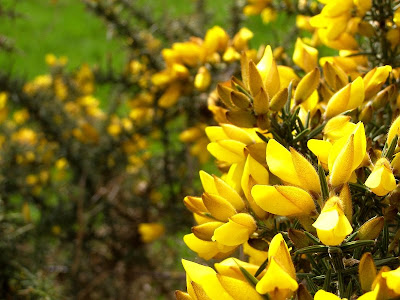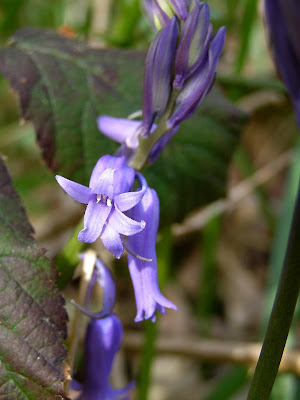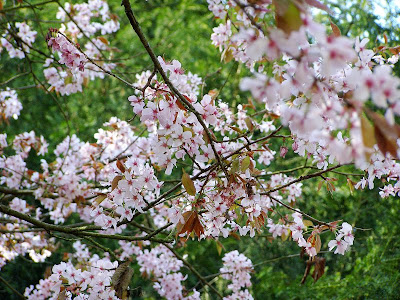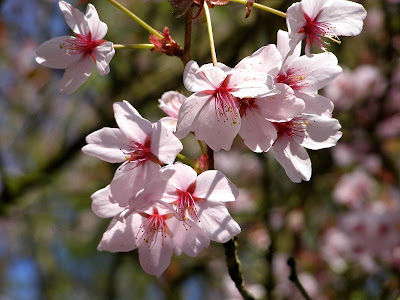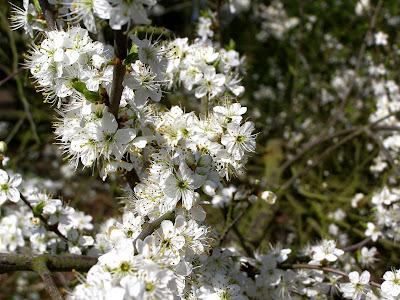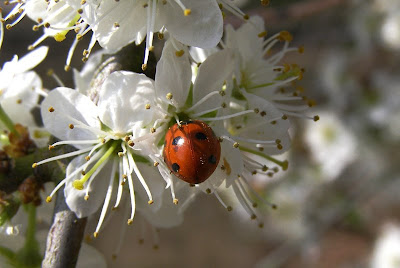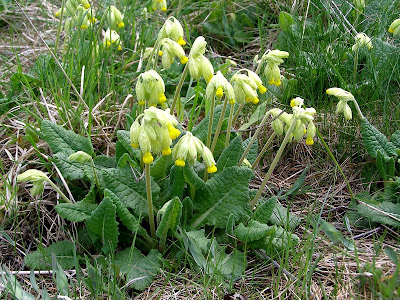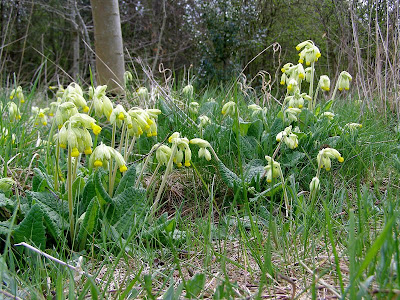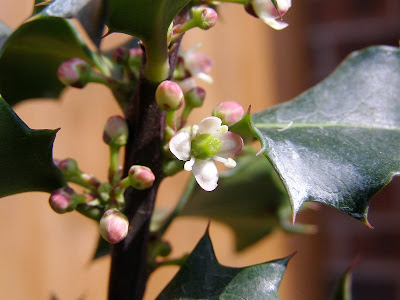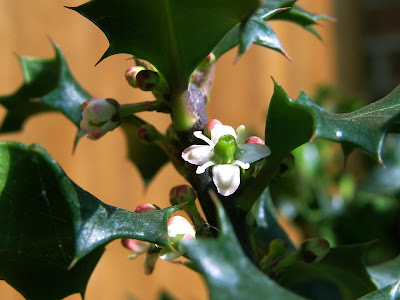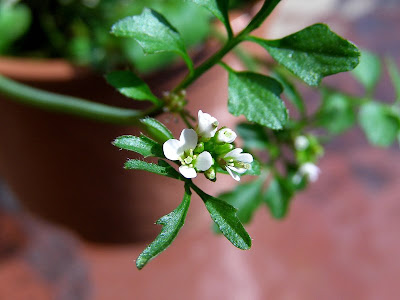With the prospects of heavy showers, Malcolm and I set out to tackle Tesco again this morning. So no country ramble for us today. We were very lucky with our timing as it started to rain just as we got home and were putting our groceries away. We're not usually that fortunate.
Just to make us all go aaahhh! here is a picture taken a few days ago as we walked around the Old Hall site on Shipley Hill. There are a few Rabbits (Oryctolagus cuniculus) about and this was a particularly sweet youngster.
The reproductive capabilities of Rabbits are well known and documented. The best example of this has to be from a small group of Rabbits which were introduced to Australia. 24 Animals were introduced in 1859 and in less than a century, they had increased to more than 600,000,000!
Welcome to my blog. Don't expect anything too high-tech or flashy, this is simply a 'diary' to share some of my photos, thoughts and observations - with a particular bias towards the natural world and the countryside around my home.
Friday 30 April 2010
Thursday 29 April 2010
First
Frederick Delius wrote the tone poem 'On Hearing The First Cuckoo of Spring' and, Malcolm and I indeed heard our first Cuckoo (Cuculus canorus) this morning. Arriving from their African wintering grounds, these birds are fast becoming a rare sight in Britain. They have been given the 'Red List' status by the RSPB as their numbers have crashed over the last 25 years. Cuckoos don't stay long in Britain, each Summer, departing again for Africa in July or August, so make the most of them when you see - or hear - them.
At last, the Bluebells have started to open in large enough numbers to provide a beautiful, blue carpet in the woods around these parts.
Common Bluebells (Hyacinthoides non-scripta) are a great favourite in the British countryside and indeed, Britain is a globally important site for this species. This was recognised by the Wildlife and Countryside Act 1981 giving them protection and strengthened in 1998 under Schedule 8 of the Act making any trade in wild common bluebell bulbs or seeds an offence.
At last also, the Lords and Ladies (Arum maculatum) are starting to open their strange flower spikes. No doubt we shall see more of them at a later date.
A small beauty to end with today. The Orange-Tip Butterflies (Anthocharis cardamines) are also starting to appear, flitting around the flowers. They are especially fond of the Lady's Smock flowers I mentioned the other day, although this individual seemed more interested in the Dandelions.
At last, the Bluebells have started to open in large enough numbers to provide a beautiful, blue carpet in the woods around these parts.
Common Bluebells (Hyacinthoides non-scripta) are a great favourite in the British countryside and indeed, Britain is a globally important site for this species. This was recognised by the Wildlife and Countryside Act 1981 giving them protection and strengthened in 1998 under Schedule 8 of the Act making any trade in wild common bluebell bulbs or seeds an offence.
At last also, the Lords and Ladies (Arum maculatum) are starting to open their strange flower spikes. No doubt we shall see more of them at a later date.
A small beauty to end with today. The Orange-Tip Butterflies (Anthocharis cardamines) are also starting to appear, flitting around the flowers. They are especially fond of the Lady's Smock flowers I mentioned the other day, although this individual seemed more interested in the Dandelions.
Wednesday 28 April 2010
Busy
As Malcolm and I left the house for our walk this morning, my attention was drawn to a very busy little creature in the grass of our front lawn. There are some very large Bumblebees about at the moment and this was no exception. A White-tailed Bumblebee (Bombus lucorum).
Among the first to appear in the Spring, this is a Queen (I think) and was busy digging in the soil looking for somewhere to lay eggs and start a new colony. Indeed it was so busy, it didn't even mind me thrusting the camera at it and taking a close-up shot or two.
I mentioned yesterday, the garlic mustard growing around the footpaths of Shipley Park. This morning, several of these plants were opening their flowers in the warm sunshine and it is from these, four petaled, cross-shaped flowers, that you can see their familial connections to the cabbages. It is also from the cross-shaped flowers that the whole family gets it's name 'Cruciferae'.
Part of the walk which we have just discovered, takes us along old railway lines and the industrial heritage of the area. Here, you can clearly see the site of the old West Hallam Colliery. Opened in 1889 and Closed in 1931, the ground is still pretty sterile and black with the residue of the pits.
Among the first to appear in the Spring, this is a Queen (I think) and was busy digging in the soil looking for somewhere to lay eggs and start a new colony. Indeed it was so busy, it didn't even mind me thrusting the camera at it and taking a close-up shot or two.
I mentioned yesterday, the garlic mustard growing around the footpaths of Shipley Park. This morning, several of these plants were opening their flowers in the warm sunshine and it is from these, four petaled, cross-shaped flowers, that you can see their familial connections to the cabbages. It is also from the cross-shaped flowers that the whole family gets it's name 'Cruciferae'.
Part of the walk which we have just discovered, takes us along old railway lines and the industrial heritage of the area. Here, you can clearly see the site of the old West Hallam Colliery. Opened in 1889 and Closed in 1931, the ground is still pretty sterile and black with the residue of the pits.
Tuesday 27 April 2010
Goosey
A good walk of about 4.5 miles this morning, as Malcolm and I found another, previously unseen, footpath around Shipley Park and up towards Mapperley Village. As we approached the reservoir, below us on the waterside, was a very contented-looking Canada Goose (Branta canadensis), sitting on her nest waiting for something to happen beneath her.
Some more flowers now, found growing along our route. Firstly a Wood Forget-me-not (Myosotis sylvatica), flowering in the shade among the trees.
A taller, smoother and greener plant next, this one is a member of the Cabbage family and is called Garlic Mustard (Alliaria petiolata). This plant has a number of Old English names including Jack-by-the-hedge, Garlic Root, Hedge Garlic, Sauce-alone, Jack-in-the-bush, Penny Hedge and Poor Man's Mustard.
Lastly, another Cabbage family member and another with several common names. The Lady's Smock (Cardamine pratensis) is also known as Cuckoo Flower and Culpepper says of it "...they are excellently good for the scurvy, they provoke urine, and break the stone, and excellently warm a cold and weak stomach, restoring lost appetite, and help digestion..."
Some more flowers now, found growing along our route. Firstly a Wood Forget-me-not (Myosotis sylvatica), flowering in the shade among the trees.
A taller, smoother and greener plant next, this one is a member of the Cabbage family and is called Garlic Mustard (Alliaria petiolata). This plant has a number of Old English names including Jack-by-the-hedge, Garlic Root, Hedge Garlic, Sauce-alone, Jack-in-the-bush, Penny Hedge and Poor Man's Mustard.
Lastly, another Cabbage family member and another with several common names. The Lady's Smock (Cardamine pratensis) is also known as Cuckoo Flower and Culpepper says of it "...they are excellently good for the scurvy, they provoke urine, and break the stone, and excellently warm a cold and weak stomach, restoring lost appetite, and help digestion..."
Monday 26 April 2010
More Flora
A lovely walk this morning, trying to keep off the main footpaths to avoid joggers and cyclists. In the end we did very well and found some wonderful peace and quiet through the trees and across fields. The Cowslips (Primula veris) are magnificent at the moment. Thousands of beautiful, little, yellow flowers nodding in the breeze.
Here, growing near the lake at Straw's Bridge, they were joined by a red-flowered Primula, escaped from someones garden.
A small, low-growing flower next and one which is not well liked by gardeners. The Ground Ivy (Glechoma hederacea) is a member of the Mint family and has rather beautiful flowers, if you take the time to look closely. Culpepper says of the Ground Ivy (or Alehoof) "... it is quick, sharp, and bitter in taste, and is thereby found to be hot and dry; a singular herb for all inward wounds, exulcerated lungs, or other parts, either by itself, or boiled with other the like herbs; and being drank, in a short time it eases all griping pains, windy and choleric humours in the stomach, spleen or belly; helps the yellow jaundice, by opening the stoppings of the gall and liver, and melancholy, by opening the stoppings of the spleen; expels venom or poison, and also the plague..."
Another familiar flower next, the Lesser Celandine (Ranunculus ficaria). A persistent garden weed, but very colourful in the wild. Culpepper also has plenty to say about this "...The juice dropped into the eyes, cleanses them from films and cloudiness which darken the sight, but it is best to allay the sharpness of the juice with a little breast milk. It is good in all old filthy corroding creeping ulcers wheresoever, to stay their malignity of fretting and running, and to cause them to heal more speedily..."
To finish with for today, we walked past a very proud parent Mute Swan (Cygnus olor), standing guard next to it's nest. There were at least three eggs in the nest, but I didn't want to get too close to find out more.
Here, growing near the lake at Straw's Bridge, they were joined by a red-flowered Primula, escaped from someones garden.
A small, low-growing flower next and one which is not well liked by gardeners. The Ground Ivy (Glechoma hederacea) is a member of the Mint family and has rather beautiful flowers, if you take the time to look closely. Culpepper says of the Ground Ivy (or Alehoof) "... it is quick, sharp, and bitter in taste, and is thereby found to be hot and dry; a singular herb for all inward wounds, exulcerated lungs, or other parts, either by itself, or boiled with other the like herbs; and being drank, in a short time it eases all griping pains, windy and choleric humours in the stomach, spleen or belly; helps the yellow jaundice, by opening the stoppings of the gall and liver, and melancholy, by opening the stoppings of the spleen; expels venom or poison, and also the plague..."
Another familiar flower next, the Lesser Celandine (Ranunculus ficaria). A persistent garden weed, but very colourful in the wild. Culpepper also has plenty to say about this "...The juice dropped into the eyes, cleanses them from films and cloudiness which darken the sight, but it is best to allay the sharpness of the juice with a little breast milk. It is good in all old filthy corroding creeping ulcers wheresoever, to stay their malignity of fretting and running, and to cause them to heal more speedily..."
To finish with for today, we walked past a very proud parent Mute Swan (Cygnus olor), standing guard next to it's nest. There were at least three eggs in the nest, but I didn't want to get too close to find out more.
Sunday 25 April 2010
Beginnings
Walking around Mapperley reservoir yesterday, it was clear to see the beginnings of Spring all around. Not least of which was the appearance of the lily pads in the reservoir. These were being ignored by the Mallards who seemed more interested in the prospects of a bread bag.
Walking back and the footpaths were lined with high hedges of Hawthorn and Gorse of which the Gorse is magnificently covered in flowers at the moment.
In the darkness of the wooded areas, the Bluebells are just beginning to show some colour. A few flowers are opening, but most are still tightly closed, promising greater things later.
Walking back and the footpaths were lined with high hedges of Hawthorn and Gorse of which the Gorse is magnificently covered in flowers at the moment.
In the darkness of the wooded areas, the Bluebells are just beginning to show some colour. A few flowers are opening, but most are still tightly closed, promising greater things later.
Saturday 24 April 2010
Mooooo!
Malcolm and I were being scrutinised as we walked in the sunshine, towards the Mapperley reservoir. A small herd of bullocks, which are normally to be seen in the distance, huddled together in the farthest corner of the field, had crowded into the corner nearest the footpath, to get a better look at us.
While some were only interested in the grass, others took a great interest in us as we passed. Especially this young man..
Next, working as a typical BBC Radio link, we jump from cattle........ to Daisies.
Familiar to us all, the Daisies (Bellis perennis) are adding a welcome splash of colour to the lawns and wild grasslands all over Britain at the moment.
Another useful plant according to Nicholas Culpeper, Daisies are to be used for ..."wounds in the breast, and very fitting to be kept both in oils, ointments, and plaisters, as also in syrup..."
A 'decoction' of daisies is also good for curing "all ulcers and pustules in the mouth or tongue, or in the secret parts." So, if you have problems with your 'secret parts'....stick a daisy on it!!!!
While some were only interested in the grass, others took a great interest in us as we passed. Especially this young man..
Next, working as a typical BBC Radio link, we jump from cattle........ to Daisies.
Familiar to us all, the Daisies (Bellis perennis) are adding a welcome splash of colour to the lawns and wild grasslands all over Britain at the moment.
Another useful plant according to Nicholas Culpeper, Daisies are to be used for ..."wounds in the breast, and very fitting to be kept both in oils, ointments, and plaisters, as also in syrup..."
A 'decoction' of daisies is also good for curing "all ulcers and pustules in the mouth or tongue, or in the secret parts." So, if you have problems with your 'secret parts'....stick a daisy on it!!!!
Friday 23 April 2010
Fruit
Some more pictures today, of the ornamental fruit trees which are flowering beautifully around and about. Starting with some more Cherry blossom.
Pale pink against the bright, blue skies of the last few days, they are attracting flies and bees in vast numbers. The darker, red central patterning acting as a guide to those insects to direct them to the nectar within.
Another of the same family next. The Blackthorn bushes are covered with white flowers, sparkling in the sunlight. You might know them better as Sloes.
Lastly, a large, ornamental bush which is well known to gardeners. The ornamental Currants (Ribes sanguineum) are in full, red bloom around Shipley Hill. Here, pictured behind the Forsythia trees, flowering in the foreground. These two shrubs were also alive with bees.
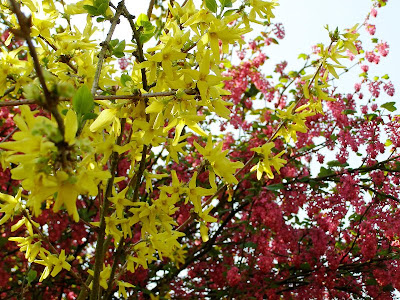
Pale pink against the bright, blue skies of the last few days, they are attracting flies and bees in vast numbers. The darker, red central patterning acting as a guide to those insects to direct them to the nectar within.
Another of the same family next. The Blackthorn bushes are covered with white flowers, sparkling in the sunlight. You might know them better as Sloes.
Lastly, a large, ornamental bush which is well known to gardeners. The ornamental Currants (Ribes sanguineum) are in full, red bloom around Shipley Hill. Here, pictured behind the Forsythia trees, flowering in the foreground. These two shrubs were also alive with bees.

Thursday 22 April 2010
Flying things
No blog yesterday, as Malcolm and I had to go to Manchester airport to collect Malcolm's mum and her friend, who finally flew in from their holiday in (of all places) Iceland!
It turned out to be an eventful morning, as we got to Manchester and found the 'Aircraft-observation area' near the airport and parked up to wait for Pat's flight to come in. We had been there about half an hour and had eaten our lunch, when a Police car pulled up alongside and two uniformed officers informed us we should not be there (despite the park being included on the map), and if we wanted to watch the planes coming in, we would have to go to the new plane-spotting area the other side of the airport......and pay £2 for the privilege!!!! Needless to say, we were not about to pay for something that we could get for free, so we drove onto a housing estate on the outskirts of Withenshaw and sat directly under the flightpath of the incoming planes. There we waited for Pat's plane.....until , there it was!
All is quiet and calm today, by comparison. A glorious day, so we had a long walk around Shipley Hill to make the most of the Blossom. the Bluebells are just starting to show some colour, so I will be including those in days to come, but for today, we were pleased to see this charming little flier on a cherry flower, A 7-Spot Ladybird (Coccinella septempunctata).
A little further on, and another little aviator was found, feeding on the nectar of the cherry blossom, this time a Peacock Butterfly (Inachis io).
Looking beautiful against the bright, blue sky and with the sun shining on the blossom, all was tranquility after the rush of yesterday. Keep calm and carry on!
It turned out to be an eventful morning, as we got to Manchester and found the 'Aircraft-observation area' near the airport and parked up to wait for Pat's flight to come in. We had been there about half an hour and had eaten our lunch, when a Police car pulled up alongside and two uniformed officers informed us we should not be there (despite the park being included on the map), and if we wanted to watch the planes coming in, we would have to go to the new plane-spotting area the other side of the airport......and pay £2 for the privilege!!!! Needless to say, we were not about to pay for something that we could get for free, so we drove onto a housing estate on the outskirts of Withenshaw and sat directly under the flightpath of the incoming planes. There we waited for Pat's plane.....until , there it was!
All is quiet and calm today, by comparison. A glorious day, so we had a long walk around Shipley Hill to make the most of the Blossom. the Bluebells are just starting to show some colour, so I will be including those in days to come, but for today, we were pleased to see this charming little flier on a cherry flower, A 7-Spot Ladybird (Coccinella septempunctata).
A little further on, and another little aviator was found, feeding on the nectar of the cherry blossom, this time a Peacock Butterfly (Inachis io).
Looking beautiful against the bright, blue sky and with the sun shining on the blossom, all was tranquility after the rush of yesterday. Keep calm and carry on!
Tuesday 20 April 2010
Primula
A walk in the sunshine this morning, trying to keep out of the wind which was quite strong. We were delighted to see a large number of Cowslips (Primula veris), in full flower, thrusting up through the grassland.
There were hundreds of these small, yellow flowers all over the place. Cowslips have many different folk-names and are know variously as Peagles, Peggles or Paigles, Key Flower, Key of Heaven, Fairy Cups, Petty Mulleins, Crewel, Buckles, Palsywort, Plumrocks, and many, many more.
The Spanish have used the leaves of these plants for centuries, as a salad leaf. Nicholas Culpepper, writing in the mid 17th Century, said of the Cowslip "...The flowers are held to be more effectual than the leaves, and the roots of little use. An ointment being made with them, takes away spots and wrinkles of the skin, sun-burning, and freckles, and adds beauty exceedingly; they remedy all infirmities of the head coming of heat and wind, as vertigo, ephialtes, false apparitions, phrensies, falling-sickness, palsies, convulsions, cramps, pains in the nerves; the roots ease pains in the back and bladder, and open the passages of urine. The leaves are good in wounds, and the flowers take away trembling....". Very useful!
A few days ago, I mentioned the Wood Anemones growing around Shipley Park. Those were, sadly unopened as it was a dull day. This morning however, the flowers were all fully open and displaying their beauty to all.
There were hundreds of these small, yellow flowers all over the place. Cowslips have many different folk-names and are know variously as Peagles, Peggles or Paigles, Key Flower, Key of Heaven, Fairy Cups, Petty Mulleins, Crewel, Buckles, Palsywort, Plumrocks, and many, many more.
The Spanish have used the leaves of these plants for centuries, as a salad leaf. Nicholas Culpepper, writing in the mid 17th Century, said of the Cowslip "...The flowers are held to be more effectual than the leaves, and the roots of little use. An ointment being made with them, takes away spots and wrinkles of the skin, sun-burning, and freckles, and adds beauty exceedingly; they remedy all infirmities of the head coming of heat and wind, as vertigo, ephialtes, false apparitions, phrensies, falling-sickness, palsies, convulsions, cramps, pains in the nerves; the roots ease pains in the back and bladder, and open the passages of urine. The leaves are good in wounds, and the flowers take away trembling....". Very useful!
A few days ago, I mentioned the Wood Anemones growing around Shipley Park. Those were, sadly unopened as it was a dull day. This morning however, the flowers were all fully open and displaying their beauty to all.
Monday 19 April 2010
Ancient
When you look at the gloriously flowering Magnolia trees at this time of year, take a moment to think that these plants are among the oldest known flowering plants on the planet. The Magnolia family of plants has been around for at least 95 million years and the flowers developed before the evolution of bees to pollinate them.
You will notice that the petals, although very pretty, are rather thick and 'leathery'. This is a defence mechanism to stop the beetles which originally pollinated them, from eating through to get to the nectar and pollen within. This fine specimen is to be found growing in a garden near Malcolm's mum's house and is a Magnolia soulangeana, a hybrid between Magnolia denudata and Magnolia liliiflora. So, that's clear!
A strange plant next, which was to be seen flowering in the beds around the old Hall site on Shipley Hill. The Stinking Hellebore (Helleborus foetidus) has a nasty name, which relates to the scent of the flowers. Also known as 'Dungwort' it is a member of the Buttercup family. You may be more familiar with another member of this family, the Christmas Rose (Helleborus niger).
All parts of this plant are poisonous, containing glycosides. Symptoms of intoxication include violent vomiting and delirium.
It's not just the flowers which provide the colour on Shipley Hill. These two pictures are of a Tibetan Cherry tree (Prunus serrula).
The bark of this tree peels off in thin strips and reveals a rich, reddish golden colour as the new bark is exposed, leading to it's alternative name of Paper-bark Cherry. The colour almost glows in the sunshine, who needs flowers?
You will notice that the petals, although very pretty, are rather thick and 'leathery'. This is a defence mechanism to stop the beetles which originally pollinated them, from eating through to get to the nectar and pollen within. This fine specimen is to be found growing in a garden near Malcolm's mum's house and is a Magnolia soulangeana, a hybrid between Magnolia denudata and Magnolia liliiflora. So, that's clear!
A strange plant next, which was to be seen flowering in the beds around the old Hall site on Shipley Hill. The Stinking Hellebore (Helleborus foetidus) has a nasty name, which relates to the scent of the flowers. Also known as 'Dungwort' it is a member of the Buttercup family. You may be more familiar with another member of this family, the Christmas Rose (Helleborus niger).
All parts of this plant are poisonous, containing glycosides. Symptoms of intoxication include violent vomiting and delirium.
It's not just the flowers which provide the colour on Shipley Hill. These two pictures are of a Tibetan Cherry tree (Prunus serrula).
The bark of this tree peels off in thin strips and reveals a rich, reddish golden colour as the new bark is exposed, leading to it's alternative name of Paper-bark Cherry. The colour almost glows in the sunshine, who needs flowers?
Sunday 18 April 2010
Small
A couple of very small flowers today. Firstly, a familiar Tree, but less familiar flower. The Holly is more usually seen covered in red berries, but the flowers also rather gorgeous - if a little on the small side.
The trees are 'dioecious' which means that male and female flowers are found on different plants. For this reason, anyone wanting to grow Holly in the garden in the hopes of getting lots of berries for Christmas and the birds, must make sure they get female plants.
A wild flower found in our lawn and garden borders next. This is a member of the cabbage family, the 'Cruciferae', Hairy Bitter-cress (Cardamine hirsuta) and the flowers are very tiny at about 2mm across.
Hairy Bitter-cress once formed part of the 'Nine Herbs Charm', a tenth century, Old English Charm to counteract the effects of poison. The charm also included things like Nettles, Mugwort, Thyme and Fennel.
The trees are 'dioecious' which means that male and female flowers are found on different plants. For this reason, anyone wanting to grow Holly in the garden in the hopes of getting lots of berries for Christmas and the birds, must make sure they get female plants.
A wild flower found in our lawn and garden borders next. This is a member of the cabbage family, the 'Cruciferae', Hairy Bitter-cress (Cardamine hirsuta) and the flowers are very tiny at about 2mm across.
Hairy Bitter-cress once formed part of the 'Nine Herbs Charm', a tenth century, Old English Charm to counteract the effects of poison. The charm also included things like Nettles, Mugwort, Thyme and Fennel.
Saturday 17 April 2010
Sunny
No country walk this morning, despite the beautiful weather, as we had to take a walk to Tesco (how I hate that place on a Saturday morning). No sign of the volcanic ash which seems to be blighting the whole of Europe at the moment - not even any sign of spectacular sunsets. So, here are some more pics from our walk yesterday. Starting with a curious-looking flower and one which doesn't even look like a flower - that of the Ash tree (Fraxinus excelsior). A member of the Oleaceae family which includes the Olive tree, Jasmine and Forsythia, among others. The leaves of the Ash are always among the last to appear each year, but the flowers are much earlier.
A much more recognizable flower next, that of a Cherry tree (species unknown) which was showing it's finest floral decoration in he sunshine.
Another Cherry next, this time a Wild Cherry (Prunus avium). The Latin name means 'Bird Cherry' but the tree which we know as Bird Cherry, has the Latin name Prunus padus! It's all rather confusing.
A delightful little creature to end with today. Two Grey Squirrels (Sciurus carolinensis) were nibbling on a pile of seeds which someone had left (presumably for the birds) on a felled tree.
They didn't seem too bothered by me taking their picture and just got on with the job of eating. There is one strange fact which comes from it's Latin name 'Sciurus'. Skia means Shadow and oura means tail and put together, it alludes to the animal sitting in the shade of it's own tail. A delightful idea!
A much more recognizable flower next, that of a Cherry tree (species unknown) which was showing it's finest floral decoration in he sunshine.
Another Cherry next, this time a Wild Cherry (Prunus avium). The Latin name means 'Bird Cherry' but the tree which we know as Bird Cherry, has the Latin name Prunus padus! It's all rather confusing.
A delightful little creature to end with today. Two Grey Squirrels (Sciurus carolinensis) were nibbling on a pile of seeds which someone had left (presumably for the birds) on a felled tree.
They didn't seem too bothered by me taking their picture and just got on with the job of eating. There is one strange fact which comes from it's Latin name 'Sciurus'. Skia means Shadow and oura means tail and put together, it alludes to the animal sitting in the shade of it's own tail. A delightful idea!
Subscribe to:
Posts (Atom)
